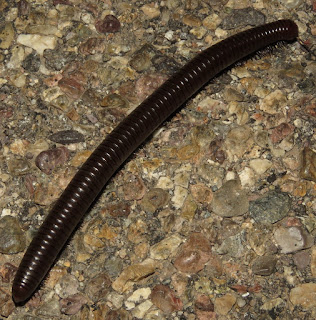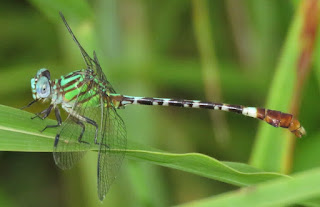It was unusual for my Marvelous Mato Grosso tour to cancel because of too few sign-ups, but I was glad to have the time to continue my search for a place to rent in Oregon as well as enjoy my last summer in southeastern Arizona. I packed the month full of outings.
My first little field trip at the beginning was to the Butterfly Peak trail with my friend Patty. In the mountains just north of Tucson you can drive to a habitat and climate that is a huge relief from the hot, dry desert. Patty is rather fond of spiders and is good at spotting them. I eventually identified this one as Frontinella huachuca in the odd little family Linyphiidae, the sheetweb and dwarf weavers.
We also saw some nice birds, including this cooperative Olive Warbler – which is not olive, nor a warbler of any kind. It’s rather shaped like a warbler but in its very own family, distantly related to the family of New World warblers.
My next outing was a night drive near the Ironwood Forest National Monument, another way to escape the heat and see some interesting critters. It was fun to show five-year-old Roland his first Regal Horned Lizard, Phrynosoma solare.
A common sight crossing the roads in this area is the spirobolid millipede Orthoporus ornatus.
At home I monitored the porch light every evening, finding a few moths and other insects. This erebid is the common Heteranassa mima.
I found time to try some new rye bread recipes, including this Fränkisches Krustenbrot.
A long-planned night of bug lighting with Margarethe Brummerman was in store, and one last time I chose Puerto Canyon just south of Tucson as the destination. Margarethe had never been there, and the thornscrub-like vegetation on the north slopes surely would host some interesting moths (and maybe a Buff-collared Nightjar would have taken up residence). There were no nightjars other than Common Poorwill, but we found quite a few local species of invertebrates at the northern edge of their range. While Margarethe mostly concentrated on beetles, and I photographed many moths, the sheets were really very busy with all kinds of invertebrates.
My posting of this photo to iNaturalist finally spurred the antlion experts to dive into the primary literature and figure out that this and a very few other sightings from SE Arizona belong to the name Glenurus snowi. One of the best field marks that distinguishes it from the much more common and well-known Glenurus luniger seems to be the two isolated black spots in the tip of the hind wing, though the fore wing pattern is also consistently different.
I had some nice mornings sipping coffee and having breakfast in the Vine Avenue back yard, watching lizards, rabbits, bugs, and birds. One morning was particularly alive, and I watched this Cooper’s Hawk eyeing the Rock Squirrel burrow before it came to have a drink at the ouflow from my evaporative cooler.
Abert’s Towhees were rare in this part of town when I first moved here, but now there is a pair that breeds here every year.
In the middle of July I decided to spend a full week in and near Austin to learn more about odonata and meet people who are also passionate about them. First, based in Bastrop for a weekend, was the Dragonfly Society of the America’s annual member meeting, with several field trips to all the best local spots. Almost everything was new for me here, and I really enjoyed the diversity of clubtails, dragonflies in the family Gomphidae (of which there are comparatively few in the West and in the tropics). This one is the Broad-striped Forcepstail, Aphylla angustifolia.
This Blue-faced Ringtail, Erpetogomphus eutainia, is a very rare and local species in Texas, so it was a special field trip to the one park where it is known to occur.
The week following the DSA weekend was the biannual ICO, International Congress of Odonatology, hosted by the Worldwide Dragonfly Association. There was one field trip at the end of the week, but this meeting of people from all over the world was more academic, featuring talks and workshops from and for people who study dragonflies. The poster sessions was really good, and it was great to meet so many new people.
It was especially fun to hang out with Dennis Paulson and Netta Smith, who were with me 11 years ago on my Galapagos tour.
All this week, I was contemplating a Zillow ad that my friend Tim Meinzen emailed me just a few days before I left for Texas. I had actually just found a little cottage for rent in Eugene that wasn’t ideal but offered the security of landlords in the main house onsite, and the rent was reasonable. It was smaller than where I had been living in Tucson and didn’t have much of a yard to garden in, but I was seriously considering it for at least a year until something better came up. It wasn’t far from where Tim lives, and he even walked down there to check it out for me, but this Zillow ad was the house right next door to Tim and his wife Lisa. It looked amazing, but it was a house for sale, not for rent. The problem for me is that I travel so much for my job, and a house that might have issues that need immediate attention really requires that someone be home. My landlords in Tucson, for example, replaced the back door and windows both times I was burgled, as well as cleaned up a huge mess when the living room ceiling collapsed and deposited a strange blow-in insulation all over my books and furniture. They were there when the gas company noted a leak in my line and had to replace the entire connection from the street. I couldn’t really be a house owner, but…the house was perfectly small and the yard perfectly large. It was already landscaped by owners who cared about birds and insect pollinators, and they had planted fruit trees, constructed organic raised vegetable beds, and installed rain catching barrels. The plumbing and electrical were all new and up to code, as were the windows and siding. It was well insulated, recently painted, and had a roof that should have another 15 years on it. Then when Tim said they could keep an eye on the house when I’m away on tour, as well as keep the feeders full and even mow the lawn for me, I knew I needed to see the house for myself and figure out if I could actually afford it.
Instead of flying back to Tucson, I simply bought a one-way ticket from Austin to Eugene on the Saturday after the dragonfly meeting, not knowing how long it would take me to decide and maybe look at a couple other places. But to make a long story short, I bought the house and flew back to Tucson on Tuesday. Here’s me with my future new neighbors (and the banana bread I baked while staying with Alan Contreras).
Back in Arizona I began earnestly going through all my stuff, trying to get rid of as much as possible, while also cramming in as many outings as possible. A day trip with my young friend Dorian Escalante and his mom Glenda was something I’ve been meaning to do for some time. I was back up into the Santa Catalina mountains for the second time in a month.
Dorian is really good with bird voices and is even getting into invertebrates, so we had a good time with everything. Even Glenda is getting into birds now, so seeing this Red-faced Warbler was a treat.
One last outing at the end of the month was another night drive with my friends Scott and Erin Olmstead and Nick Kemme, down to the mesquite desert grasslands in the western foothills of the Patagonia Mountains, close to the Mexican border. We saw plenty of toads, a gorgeous Black-tailed Rattlesnake, and three species of scorpions. I didn’t know it, but this turns out to the best location for the local species Diplocentrus spitzeri.
By far the best find of the night was this stunning Sonoran Mountain Kingsnake. Some authorities now split this form from ones farther south and east as Lampropeltis knoblochi.

























No comments:
Post a Comment